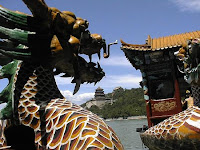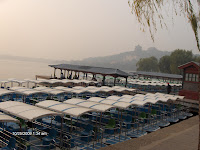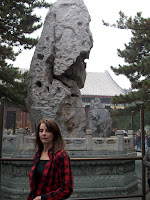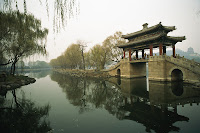Our next attraction in Beijing was the Summer Palace.
The Summer Palace
pinyin (Roman Alphabet): Yíhé Yuán;
literally "Gardens of Nurtured Harmony"
After the Great Wall and the Forbidden City, the Summer Palace is often considered to be the next must see place to visit for any tourists in Beijing.
Click on the map to enlarge.
The Summer Palace, Yihe yuan in Chinese, is the largest and best-preserved imperial garden in the world, a veritable museum of classical Chinese garden architecture.
In 1998, it was listed as one of the World Heritage Sites by UNCESCO, and it declared the Summer Palace "a masterpiece of Chinese landscape garden design".
The natural landscape of hills and open water is combined with artificial features such as pavilions, halls, palaces, temples and bridges to form a harmonious ensemble of outstanding aesthetic value. It is a popular destination but also serves as a recreational park.
Below is an 'birds eye view' representation of the area to help you to get an overview of the palace grounds.
Click on the picture to enlarge.
Situated in the western outskirts of Haidian District, western edge of Beijing between the fourth and fifth ring roads, 15 kilometers from central Beijing, the Summer Palace, constructed in the Jin Dynasty (1115-1234), was extended continuously in the later time, and had become a luxurious royal garden providing royal families with rest and entertainment by the time of the Qing Dynasty.
Highlights of the Summer Palace
- Longevity Hill Area: The hill is about 60 meters high and houses many buildings positioned in sequence, built in Qing Dynasty (1644-1911). The front hill is rich in splendid halls and pavilions; while the back hill, in sharp contrast, is quiet with nature beauty.
- Kunming Lake Area: Kunming Lake is the central lake on the grounds of the Summer Palace, forming the key landscape features of the gardens, together with the Longevity Hill. It covers approximately three quarters of the Summer Palace, with an area of 2.2 square kilometers. Since the lake develops a solid ice cover in winter, it is used for ice skating.
- Long Corridor: The "Long Corridor" is a covered walkway. 795 yards long that runs by Kunming lake. It is the longest walkway in any Chinese garden, with over 14,000 traditional Chinese paintings on the beams and crossbeams. The function of corridors in Chinese garden architecture is to offer a seltered passageway from direct sun as well as inclement weather when passing between buildings.
We entered the grounds through a ornately decorated gate...
At the boat docks we could see the bridge and the island it connects to through the smoggy haze.
We were supposed to take boats out on the lake. When we arrived, however, we were told that due to recent drought conditions that the lake's water levels were too low to allow any boats to go out. There was a man with his daughter in native dress hoping to make some money posing for photographs.
To the west and north we looked out over the lake and at the Palace in the distance shrouded in the haze.We strolled north along the willow lined promenade toward the Palace.
We passed through the gate and entered into the palace complex. Our time was very limited and we saw precious little of the Summer Palace. Inside the gate we saw the Hall of Benevolence and Longevity, the building that housed the throne upon which Empress Dowager Cixi sat and received foreign state dignitaries.
Our guide Joan.
It was very busy and crowded as people tried to find just the right spot to snap their photos. The favorite subjects seemed to be the various dragons, lions, birds and Chinese unicorns ..





If you are interested, here is a little history of the Summer Palace compound.
The Summer Palace has a history of over 800 years. It started in the early 12th century when the Golden Hill Palace was built in 1153.
 Construction: Large scale construction of the Summer Palace was taking place during the reign of Emperor Qianlong in the Qing Dynasty (1644-1911). At that time, the Qing Dynasty was in its heyday and China was a powerful Asian country with vast territories. With supreme power and large sums of money, Emperor Qianlong summoned skillful and ingenious artisans from all over the country to carry out this construction work in honor of his mother's birthday. After 15 years and one seventh of the nation's annual revenue spent, the Garden of Clear Ripples was completed and served as a testimony to China's scientific and technological achievements.
Construction: Large scale construction of the Summer Palace was taking place during the reign of Emperor Qianlong in the Qing Dynasty (1644-1911). At that time, the Qing Dynasty was in its heyday and China was a powerful Asian country with vast territories. With supreme power and large sums of money, Emperor Qianlong summoned skillful and ingenious artisans from all over the country to carry out this construction work in honor of his mother's birthday. After 15 years and one seventh of the nation's annual revenue spent, the Garden of Clear Ripples was completed and served as a testimony to China's scientific and technological achievements.Destruction: The Summer Palace has fallen prey to two acts of destruction. The first took place in 1860 when the Anglo-French forces invaded Beijing and ravaged both the Yuanming Yuan Garden (Garden of Perfection and Brightness) and the Park of Pure Ripples. Every single building in the park was destroyed by fire except nonflammable structures such as bronze pavilions and stone pagodas.
After big fires set by the foreign invading forces in 1860 and 1900, only some broken stone pillars and collapsed arches of a group of western-style buildings survived. (see more here)
The second great act of destruction took place in 1900 when the Eight-Power Allied Forces invaded Beijing. The great temples rebuilt in the 1880s were completely demolished and almost every valuable object in sight stolen by the invading troops. In 1902
Rebuild: In 1888, Empress Dowager Cixi diverted 30 million taels of silver originally designated for the Chinese navy into the reconstruction and enlargement of the Summer Palace. She had the southern side of Longevity Hill laid out in imitation of West Lake in Hangzhou and the northern face in the architectural style of Suzhou. She gave the park its present name: Yiheyuan (Garden of Good Health and Harmony), known generally in English as the Summer Palace.
When Empress Dawager Cixi returned to Beijing from Xi' an, she ordered the reconstruction of the park. According to historical records, she "rebuilt the Summer Palace with unbounded extravagance and opulence, spending some 40,000 taels of silver per day. Singing and dancing went on without end."
 Liberate: After the Revolution of 1911, the Summer Palace became the private property of the deposed Emperor Puyi, who in 1914 opened the garden to the public. The entrance fee was so high that the palace had very few visitors. In 1924, Puyi, the last Emperor was driven out of the Forbidden City by the "Christian" General Feng Yuxiang, the Summer Palace turned from an imperial garden into a public park. The Summer palace once again fell prey to full-scale devastation; pavilions and covered corridors were destroyed, lakes became silted up, vegetation withered and died, and antiques and other objects of value were lost.
Liberate: After the Revolution of 1911, the Summer Palace became the private property of the deposed Emperor Puyi, who in 1914 opened the garden to the public. The entrance fee was so high that the palace had very few visitors. In 1924, Puyi, the last Emperor was driven out of the Forbidden City by the "Christian" General Feng Yuxiang, the Summer Palace turned from an imperial garden into a public park. The Summer palace once again fell prey to full-scale devastation; pavilions and covered corridors were destroyed, lakes became silted up, vegetation withered and died, and antiques and other objects of value were lost. Puyi's story is compelling, from Emperor at the age of 3 to living out his final days as a gardener in Beijing. I highly recommend the 1987 film The Last Emperor.
Click on the videos below for previews.
Below is the closing scene of a biography, The Last Emperor of China, also very interesting and recommended.
If you would like to see the entire film here are the download links. Download all the links and join them with a program like WinRAR or jZip (click on either name for a free download link).
Present: Summer Palace of today is more or less the same as the palace rebuilt in 1903. This old imperial garden now becomes an ideal place for Beijing locals to retreat from the hot summer in Beijing.
Below are some earlier examples of various stages of the Summer Palace.
We saw a few other buildings, plazas and gardens just east of the palace itself and then eventually passed through the East Gate exiting the Summer Palace having just brushed a corner of the complex.

Below are a few photos of some of the areas of the Summer Palace that we missed but are important points of interest.

Back in the daily life of today's Beijing we made our way to the bus which would take us back to the hotel and then to the theater to see the Acrobat Show.
Up next: The Acrobat Show






















 .
.


























































 .
.































No comments:
Post a Comment